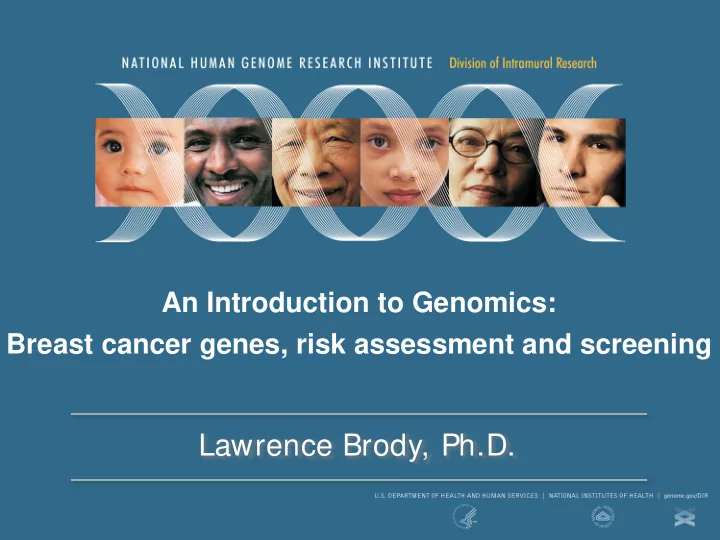

An Introduction to Genomics: Breast cancer genes, risk assessment and screening Lawrence Brody, Ph.D.
Fong et al., NEJM , 361:123-134, 2009
Breast Cancer Genes What are they? How do we find them? What is their function? How can they be used to improve health?
Change in the US Death Rates by Cause, 1950 & 2002 1950 2002 Rate Per 100,000 Heart Cerebrovascular Pneumonia/ Cancer Diseases Diseases Influenza * Age-adjusted to 2000 US standard population. Sources: 1950 Mortality Data - CDC/NCHS, NVSS, Mortality Revised. 2002 Mortality Data–NVSR-Death Final Data 2001–Volume 52, No. 3. http://www.cdc.gov/nchs/data/nvsr/nvsr52/nvsr52_03.pdf
Breast Cancer - USA 207,090 new cases 39,840 deaths per year – lifetime risk of diagnosis ~ 12% (1/8) – risk of death from breast cancer - 3.4% (1/35) ACS estimates for 2010
Cancer Death Rates: US Women, 1930-2001 Rate Per 100,000 Lung Uterus Breast Ovary Age-adjusted to the 2000 US standard population. Source: US Mortality Public Use Data Tapes 1960-2000, US Mortality Volumes 1930-1959, National Center for Health Statistics, Centers for Disease Control and Prevention, 2003.
Cancer Incidence: US Women, 1978-2008 SEER Data
Why Genetics? • Prevention • Early Detection • Prognosis • Tailored Therapy
“cancer is a genetic disease” Cells: acquire mutations associated with growth advantage and/or escape from normal controls. Somatic mutations Individuals: may inherit genetic variants that lead to an increase in cancer risk. Inherited variation
TUMOR SUPRESSOR GENES Tumor Cell Mutation Carriers
Family History and Cancer Risk In small percentage of families cancer appears to be inherited as a mendelian trait. 3-8% of breast cancer
Topography of Cancer Risk
Topography of Cancer Risk 10.0 Relative Risk Relative Risk 2.0 1.5 1.0 0.1 1.0 10.0 30.0 Minor Allele Frequency (%) Minor Allele Frequency (%) Adapted from Foulkes WD NEJM , 359:2143, 2008
Sporadic Cancer
Inherited Cancer
Breast Cancer - Age at Dx seer.nci.gov
BRCA1 Breast Cancer Gene One
BRCA2
BRCA1 and BRCA2 Families Breast ~ 8X Breast Ovarian 20-30X Prostate 2-3X
Breast Cancer Genes 10.0 TP53 Relative Risk BRCA1 BRCA2 2.0 1.5 1.0 0.1 1.0 10.0 30.0 Minor Allele Frequency (%) Adapted from Foulkes WD NEJM , 359:2143, 2008
BRCA1 Mutations and Polymorphisms 12/94 E1250ter 2477delC 926ins11 3599del 11bp 2800delA 3875del4 1128insA 2863delTC 3884del1 1201del11 Q1313ter 185delAG R1347G 1133insA 2982del5 4184del4 1294del40 188del11bp R1443ter 3121delA R1443G 1323delG C61G G1541ter Q562ter P1637L 3166ins5 C64G 2080insA 5085del19 A1708E K583E V1713A 5256delG 2294delG R1203ter 5382insC 2414delAG T826K 5398del20 5438insC M1775R Y1853ter 4427C/T 4056C/T K1183R S1040N 3233 A/G 1 kb E1038G 5024C/T Q356R V772A P871L S1613G 2430T/C 710C/T 2311 R841W D694N 2201C/T E693N
BRCA1 & BRCA2 The World’s most sequenced genes.
BRCA1 – BIC Database
BRCA1 and BRCA2 Founder Mutations Ashkenazi Jews 1/40 Icelanders 1/170 Dutch 1/333 German, Swedish, Polish, Spanish, Cypriot, Afrikaner, Malaysian
BRCA1 Mutation Data Total Distinct One Family Entries Alterations Only Nonsense 1046 176 84 Frameshift 4780 513 303 Splicing 598 175 100 Missense 2734 489 259
BRCA1 Mutation Data The Unclassified Variant Problem Missense 2734 489 259
Breast Cancer Genes • high penetrance / low frequency BRCA1, BRCA2 • low penetrance / high prevalence low relative risk, high attributable risk Association Studies!
CHEK2 - 1100delC Carriers n Controls 10,860 0.7% Breast cancer 9,065 1.9% OR= 2.34 CI 1.72-3.20 p= 0.0000001 AJHG 74, 2004
Breast Cancer Genes 10.0 TP53 Relative Risk BRCA1 BRCA2 ATM 2.0 BRIP1 CHEK2 PALB2 1.5 1.0 0.1 1.0 10.0 30.0 Minor Allele Frequency (%) Adapted from Foulkes WD NEJM , 359:2143, 2008
Genome Wide Association Study
147 Institutional Affiliations Nature 447:1087-109, 28 June 2007
Breast Cancer Genes 10.0 TP53 BRCA1 Relative Risk BRCA2 ATM 2.0 CHEK2 BRIP1 PALB2 1.5 6q FGFR2 TOX3 MAP3KI CASP8 LSP1 8q 1.0 0.1 1.0 10.0 30.0 Minor Allele Frequency (%) Adapted from Foulkes WD NEJM , 359:2143, 2008
Topography of Cancer Risk
Why Genetics? • Prevention • Early Detection • Prognosis • Tailored Therapy
Breast Cancer Genes 10.0 TP53 BRCA1 Relative Risk BRCA2 2.0 ATM CHEK2 BRIP1 PALB2 1.5 6q FGFR2 TOX3 MAP3KI CASP8 LSP1 8q 1.0 0.1 1.0 10.0 30.0 Minor Allele Frequency (%) Adapted from Foulkes WD NEJM , 359:2143, 2008
Inherited Cancer
BRCA1/ BRCA2 Mutation Associated Risk Study Type Cancer by Age 70 Family-based 80-90% Proband-based 75-85% Community-based 50-70% Population-based 30-50%
Low penetrance / High prevalence Clinical Significance? – Individual health – Public health
Genotype Driven Screening 100 Proportion of Cases Explained (%) 80 60 40 20 0 0 20 40 60 80 100 Proportion of the Population Adapted from Pharoah PD NEJM 358, 2008
Distribution of Genetic Risk in the Population Pharoah P et al. N Engl J Med 2008;358:2796-2803 Pharoah PD NEJM 358, 2008
Genotype Driven Screening 100 Proportion of Cases Explained (%) 80 60 40 20 0 0 20 40 60 80 100 Proportion of the Population Adapted from Pharoah PD NEJM 358, 2008
Why Genetics? • Prevention • Early Detection • Prognosis • Tailored Therapy
BRCA1 & BRCA2 are DNA repair proteins
Anders C K et al. Clin Cancer Res 2010;16:4702-4710
PARP1 inhibitors kill established tumors
Audeh et al., Lancet , 6 July 2010
O’Shaughnessy NEJM Jan 2011 vol. 364
Tutt et al., Lancet , 6 July 2010
Why Genetics? • Understand Mechanism • Refine Characterization
Why Genetics? • Prevention • Early Detection • Prognosis • Tailored Therapy
Last slide
Mutation Database (BIC) BRCA1 11,672 BRCA2 11,171
Breast Cancer Genes - GWAS Genes Pop. Risk Attributable Allele Relative Gene Risk Freq Risk 10% TNRC9 0.25 1.20 19% FGFR2 0.38 1.26 “2q” 0.58 1.20 7% CASP8 0.86 1.13 20% Adapted from Pharoah P et al. N Engl J Med 2008;358:2796-2803
Tailored therapy? Bryant et al., Nature, 434: 913, 2005 Farmer et al., Nature, 434: 917, 2005
Recommend
More recommend